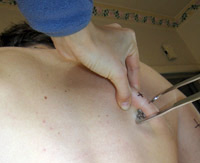Instructions for Taking Skinfold Measurements
Here are general instructions for taking skinfold measurements. For accuracy, it is important to use the correct technique. Below is a description of the standardized technique that is used around the world.
See also the specific instructions for using the Accu-Measure 3000 Skinfold Caliper.
 equipment: skinfold caliper, such as the Accu-Measure Body Fat Caliper
equipment: skinfold caliper, such as the Accu-Measure Body Fat Caliper- procedure: Measurement of body fat using the skinfold method can use from 1 to 9 different standard anatomical sites around the body. In the case on the Accu-Measure caliper, only one site is required for accurate results (suprailliac). The right side is usually only measured (for consistency). The tester pinches the skin at the appropriate site to raise a double layer of skin and the underlying adipose tissue, but not the muscle. The calipers are then applied 1 cm below and at right angles to the pinch, and a reading in millimeters (mm) taken two seconds later. The mean of two measurements should be taken. If the two measurements differ greatly, a third should then be done, then the median value taken.
- the sites: Accu-Measure recommend using just the suprailliac site. Other popular measurement sites include: Triceps, Biceps, Subscapular, Thigh, Iliac Crest, Supraspinale, Abdominal, Calf, Chest and Axilla.
- results: To avoid additional errors, sometimes just the sum of the skinfold measurements is used as the score, otherwise appropriate formula or tables are used to convert skinfold measures to percentage body fat (%BF).
- reference: International Standards for Anthropometric Assessment (2001) published by The International Society for the Advancement of Kinanthropometry (ISAK).